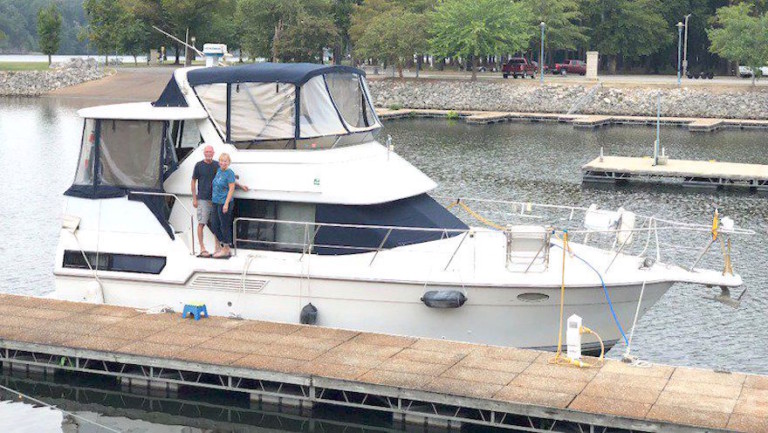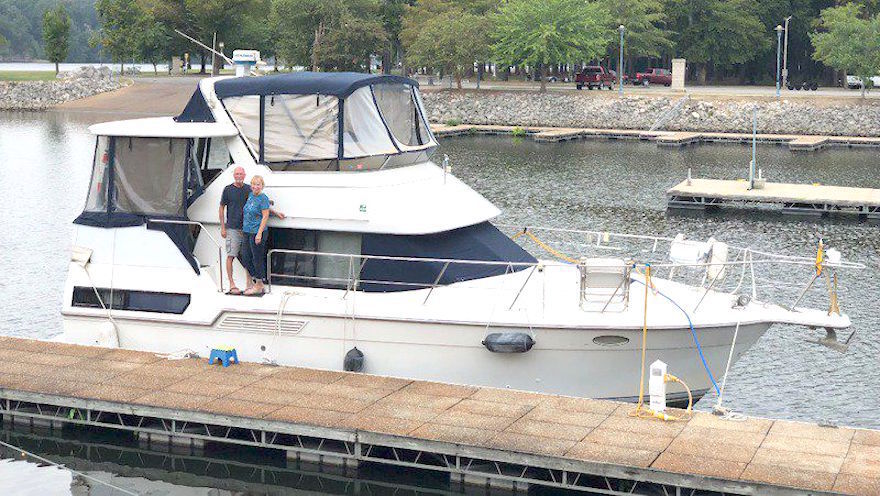
MOORE, Okla.: For over a year, Pat and Cathy Deadwiley weren’t residents of their Moore home. They were residents of the open seas.
Well, it wasn’t always a sea. Often it was a river, a canal, an inlet or a bay. But it was always aboard their boat, the Southern Cross, and always on the Great American Loop.
“It had all the things we were looking for to do in retirement,” Cathy Deadwiley told The Norman Transcript . “Travel, be with people who like to do what we do, adventure; it hit all the points.”
The Great American Loop is a series of waterways linking the Eastern United States together, including the Mississippi and Tennessee Rivers, the Gulf of Mexico, Lake Okeechobee in Florida, the Atlantic Coast, the Erie Canal and the Great Lakes. The Deadwileys spent 13 months on the water, starting in northern Alabama where they bought the boat and finishing there to officially “cross your wake,” or officially complete the loop, Cathy Deadwiley said.
A Great American Loop flag that flew with them signaling their journey is now on display in their Moore home. The gold one signifying they completed the loop is still flying on the Southern Cross where it is docked along the Tennessee River.
It’s one of the greatest American journeys anyone can take, from the people, places, history, to the food, fun and friends. Will the Deadwiley’s be going again?
“Absolutely,” Cathy Deadwiley replied.
But how did a couple who had spent decades in landlocked Oklahoma find their way to a cross-country trek over water?
“It was the most asked question,” Pat Deadwiley said. “They’d see `Norman, Oklahoma’ on the boat and sit there kind of dumbfounded. They’d ask me, how’d you get here? Well, the story starts on the Arkansas River, which most people in Oklahoma don’t even know you can go down there.”
It definitely takes some preparation, something the recently retired Cathy Deadwiley, who worked 38 years as a registered nurse at Norman Regional, and Pat Deadwiley, a homebuilder who was winding down his career with St. Gregory’s University, had time for. They sold a larger home they owned in Norman and downsized to Moore.
It was Pat Deadwiley’s niece and her husband, also boat owners, who first got them interested in the loop. Pat Deadwiley said he went to Memphis and rode with him down the Mississippi and across on the Arkansas back to Oklahoma.
“So I did, and that was, like, wow,” he said. “I had never been on a bigger boat like that.”
The couple then joined them on a cruise down the Mississippi to the Gulf of Mexico. It was enough to convince the Deadwileys that the Great American Loop was worth trying.
They researched and found a boat in Arkansas. In 2016, they set off from Alabama, officially starting their own trek on the loop.
“You only go about 8 miles an hour,” Cathy Deadwiley said. “So you’re seeing things you don’t see from the road. You’re seeing the wilderness, I guess you would say. It’s just beautiful.”
From where they began, the Deadwileys headed south down the Tennessee River and entered the Gulf at Mobile, Alabama. That’s where they entered the inter-coastal waterways, which were intended for the large container ships but now used by pleasure craft.
But mainly, they shared the water with fellow “loopers.” It was a whole community, Cathy said, and some of the people they met on the trek have now become friends who came to visit them in Oklahoma.
“The biggest thing I took away from it was the people, for one,” Pat Deadwiley said. “We rarely ever ran into anyone that wasn’t just great to talk with.”
The marina they stayed at in Alabama held a Halloween party. They spent Christmas at Fort Meyers, Florida, and all the loopers got together for a potluck.
“At 5 o’clock, everyone who’s a looper goes down to the dock with a drink and a dish, and we have a get together,” Cathy said.
One key to doing the loop is hanging in the south for the winter and making the way north once the ice has thawed. So after three months in Fort Meyers, they crossed through Florida using the Caloosahatchee Canal, coming out on the Atlantic side and heading north.
One thing Pat Deadwiley said he noticed is how the history changes state-by-state. For one thing, they noticed a lot of Alabama, Mississippi and some Florida towns and places shared names with Oklahoma communities.
After all, this was the land of the Five Civilized Tribes, members of which were forced westward into Indian Territory.
The Civil War was also a constant theme. For instance, Shiloh, Tennessee, the site of a major battle, is only about 10 minutes from where the Southern Cross is docked at this very moment.
“As you go further south, especially in Florida, you have all of that and then you start the colonies,” Pat said. “Plus, you go back even further … like St. Augustine, that originated from the Spanish coming over.”
As they traveled north along the Atlantic coast, the Deadwileys began to enter and use waterways that were used by some of the first colonists in the 17th and 18th Centuries. They went up into the Chesapeake Bay and toured around Washington, D.C. for a while.
Then came the big moment: in order to get to the Erie Canal that took them across to the Great Lakes, they had to enter the mouth of the mighty Hudson River. It was a sight to behold for Cathy Deadwiley, who had never seen the Big Apple.
“This is still amazing to me,” she said. “We get up to the Hudson River, and around the bend, there’s New York City. I’ve never seen New York City.”
Far from being a place too crowded for loopers, the Deadwileys ended up staying five days there. Then it was up the Hudson to the Erie Canal, and across to the Great Lakes.
From there, they decided to take the loop’s northern route into Canada, where they unwittingly spent Canada Day – which also happens to be celebrated with fireworks – and July 4. Much of the time in Canada, Cathy Deadwiley said they would anchor the boat, take out the dinghy and explore.
“We would anchor out in a bay somewhere, get the dinghies out and go on rapids, waterfalls, climb rocks and pick wild blueberries,” she said.
Michigan was the biggest surprise package of the trip, both said. While it’s often considered an industrial area, the countryside is spacious, quaint and filled with attractions.
“They have sandy beaches, they have sand dunes,” Pat Deadwiley said. “There’s one stretch of sand dunes there that’s like 300 feet tall. You think of Michigan as an industrial area, which it is on the inside. But you get up past that, and it’s just small towns that used to be fishing towns and villages and stuff.”
The Deadwileys don’t know exactly when they’ll do the Great American Loop again, but they know they want to go. For anyone considering it, they say planning is important.
But the most important thing about doing the Great American Loop is simply committing to it.
“Just make a commitment to do it, which takes a lot, even just thinking about it I guess and getting ready to do it,” Pat Deadwiley said. “You have to have things in order at home, for certain. But once you start, you reduce it down to three weeks or a month at a time of planning. That breaks it down to where it’s manageable.” AP







